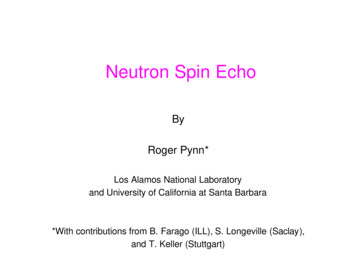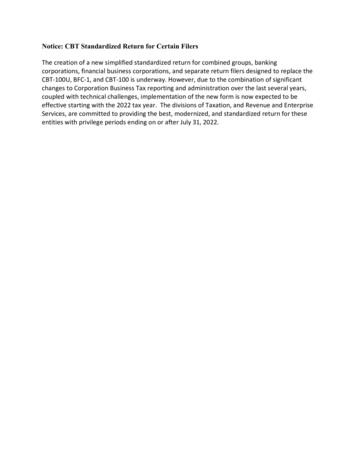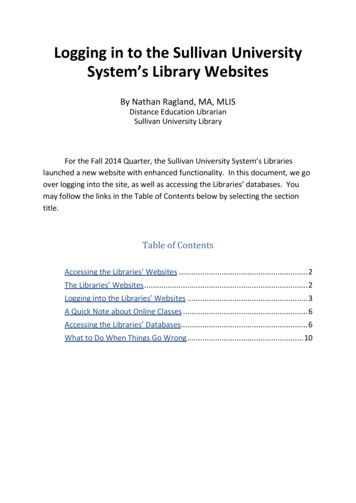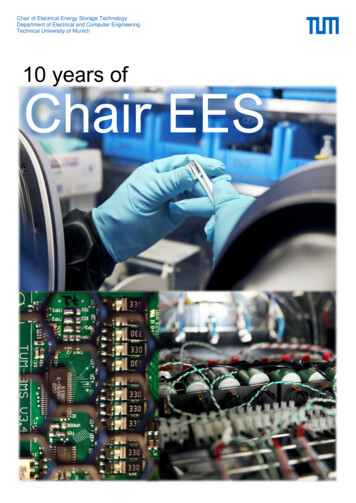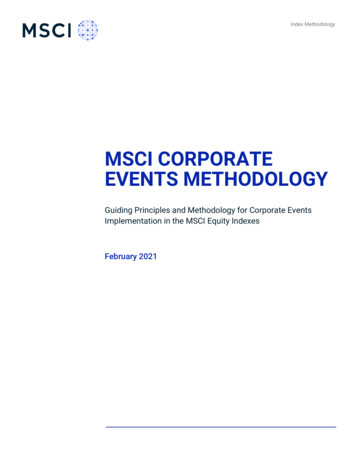
Transcription
SPINOFFS34 September 2010 practicallaw.comCopyright 2010 Practical Law Publishing Limited and Practical Law Company, Inc. All Rights Reserved.
STEPHEN M.KOTRANMALCOLM G.KATZSAMIUL E.KHANPARTNERASSOCIATEASSOCIATESULLIVAN &CROMWELL LLPSULLIVAN &CROMWELL LLPSULLIVAN &CROMWELL LLPStephen is a memberof the firm’s M&A,Financial Institutionsand Private EquityGroups and represents buyers, sellers, specialcommittees of independent directors andfinancial advisors in connection with mergersand acquisitions transactions.Malcolm is a memberof the firm’s M&Aand Securities Groupsand has advised clientsin the beverages, film, financial institutions,healthcare, insurance and private equityindustries on a range of corporate, M&A,securities and restructuring matters.Sam is a member ofthe firm’s GeneralPractice Groupand has advisedentertainment, healthcare and financialinstitutions clients regarding corporate,M&A and securities matters.For companies evaluating their strategic options,the spin-off of a subsidiary or division may be aviable alternative.In light of continued weak economic andfinancial performance and forecasts, lagging stock market valuations and significant regulatory changes and uncertainty,many companies are engaged in a continuous or episodic process of evaluatingtheir strategic alternatives. While it maynot be suitable in all cases, the spin-off of asubsidiary or a division into a stand-alonepublic company should be consideredamong these strategic options.In a typical spin-off transaction, the parentcompany (Parent) “spins off ” its subsidiary by distributing all of that subsidiary’sstock to Parent’s stockholders. After thetransaction, both Parent and the spun-offentity (SpinCo) have separate and independent existences with the stockholdersof Parent owning the stock of Parent and,initially, the stock of SpinCo.The following article explains: Key reasons why companies engagein spin-offs. The timing, process anddocumentation of a typical spin-off. Considerations regarding theallocation of assets and liabilitiesbetween Parent and SpinCo. Important tax considerations whenstructuring the transaction. USfederal securities lawrequirements and issues. Required corporate approvalsand significant director liabilityconsiderations. Corporate governance issues.As used in this article, the term “spin-off ”does not include a: Split-off, which involves Parentoffering stock in a subsidiary inexchange for a specified numberof Parent’s shares held by Parent’sstockholders. Subsidiary offering, which occurswhen Parent makes a public offeringof its subsidiary’s stock. Split-up, which involves Parentdistributing stock in its subsidiaryto its stockholders after whichParent dissolves.article is based on a Practice Note Thisavailable on practicallaw.com. For thiscontinuously maintained resource, searchSpin-offs: Overview on our website.REASONS FOR A SPIN-OFFSome of the key reasons why companiesdecide to engage in spin-offs are to: Enable management to focus itsattention on its core business, whileCopyright 2010 Practical Law Publishing Limited and Practical Law Company, Inc. All Rights Reserved.allowing non-core businessesthe resources and managementattention to develop and realize fullstockholder value. Incentivize officers and employees ofdisparate business lines by allowingmanagement of those lines toimplement appropriate employeecompensation packages without thefriction and administrative burdencreated by having differing employeecompensation metrics within thesame organization. Separate a subsidiary from Parent inpreparation for that subsidiary’s saleto a third party. Maximize stockholder value in highgrowth business lines that may beundervalued due to their performancebeing obscured by their attachment toslower-growth businesses. Shed businesses that are no longerwanted and no longer fit withinParent’s business plan but that eitherare illiquid or do not have a currentmarket valuation that Parent believesto be fair. Allow Parent and SpinCo to raisecapital and seek financing separatelywhich may allow either entity (orboth) to do so more effectively andefficiently.Practical Law The Journal September 2010 35
Establisha takeover defense. Spinningoff a subsidiary may make Parentless attractive as a takeover targetwithout destroying value for existingstockholders (as those stockholdersget the stock of the subsidiary). Avoid regulations. Following a spinoff, Parent and/or SpinCo may notbe subject to the same regulatoryregime post-transaction as they werepre-transaction and, depending onthe cost and administrative burdenof the regulations, may unlockstockholder value that wouldotherwise be suppressed. Reduce costs. Although spin-offs mayin certain circumstances have thepotential to increase costs throughloss of synergies, in certain scenarioscosts may be reduced. For example,before the spin-off, the subsidiary mayhave been subjected to extraordinarycosts by virtue of its affiliation with aparticular Parent business. Eliminate conflicts between Parentand SpinCo business lines.TIMING, PROCESSAND DOCUMENTATIONTIMING AND PROCESSA typical spin-off transaction can be completed in about six months: two monthsof pre-announcement preparation followed by four months primarily focusedon the SEC and distribution process. Fora general list of the key process tasks thatshould be taken when conducting a spinoff, see Box, Conducting a Spin-off and fora detailed sample timeline of the principal steps involved in a spin-off, see Box,Spin-off Transaction Timetable.PRIMARY DOCUMENTATIONThe distribution agreement (also referredto as the separation agreement) setsforth the basic terms and conditions ofthe spin-off, including: The assets and liabilities to beallocated to SpinCo. Cross-indemnifications of historicalliabilities.36 September 2010 practicallaw.com Representationsand warrantiesregarding the assets and liabilities tobe transferred. Tax-related covenants andindemnifications. The mechanics of the distribution.Other agreements typically necessary todocument the allocation of assets andliabilities and employees between Parentand SpinCo, post-spin-off services andother operational relationships betweenParent and SpinCo or other aspects of aspin-off include: Tax allocation agreement. Employment and benefits agreement. Intellectual property agreements. Insurance agreement. Environmental agreement. Legal proceedings agreements. Transitional services agreement. Leases. Supply agreements. Management services agreement.ASSET AND LIABILITYALLOCATIONIn any spin-off, Parent must transfer therelevant assets and liabilities to SpinCounless the assets and liabilities alreadyreside in SpinCo. Many of the considerations and issues involved in this transferare similar to the issues and considerations involved in any sale of a businessor division to a third party.GENERAL CONSIDERATIONSThe allocation of assets and liabilitiesbetween Parent and SpinCo generallytracks the underlying businesses beingretained by Parent and those being spunoff with SpinCo.Therefore, assets relatedto, or liabilities arising from, businessesthat are being spun-off generally wouldbe transferred to SpinCo.This allocation becomes difficult whenvarious assets, services or personnel areused before the transaction by both Parent and the business to be spun-off. Inaddition, if both Parent’s business andthat of SpinCo are operated in an overlapping manner, it can be difficult totrace certain known or contingent liabilities (such as environmental or litigationliabilities). In such cases, it is importantto pay careful attention to identifyingthose assets and liabilities that are staying with Parent and those that are beingtransferred to SpinCo in the distributionagreement (for example, through use ofqualifiers such as “primarily related to”or schedules of specifically enumeratedassets and liabilities).PRE-EXISTING SPINCOFor a spin-off involving a pre-existingSpinCo, conduct due diligence early todetermine which assets and liabilities tobe spun-off already reside in SpinCo andwhich ones must be transferred to SpinCo.ASSIGNMENT AND CHANGEOF CONTROL ISSUESReview all contracts to which SpinCois a party (or is intended to be a partyfollowing the transfer from Parent)in the context of the contemplatedtransaction (including the assignments,transfers, contributions, dividendand other corporate actions plannedto effectuate the spin-off) to identifyanti-assignment and change of controlprovisions that may necessitate obtaining third-party consents.SOLVENCY ANDFRAUDULENT TRANSFEREnsure that no transfer of assets or liabilities between Parent and SpinCo in connection with a spin-off subsequently maybe voidable as a fraudulent conveyance.Similar to the ultimate spin-off dividendof the shares of SpinCo, such asset andliability transfers generally are not madein return for “reasonably equivalentvalue.” Therefore, the transfers may constitute fraudulent conveyances if, at thetime of or following the transfers, thetransferring and transferee entities donot meet applicable solvency and capitalrequirements. See below Fraudulent Conveyance and Solvency Issues.Copyright 2010 Practical Law Publishing Limited and Practical Law Company, Inc. All Rights Reserved.
LIABILITIES TO THIRDPARTIES AND INDEMNITIESThe assignment of a liability in a spinoff transaction generally does notabsolve the assigning party of its obligations to a third party with respectto such liability absent the consent ofthe third party. Consequently, distribution agreements generally containcross-indemnities between Parent andSpinCo for the liabilities intended to beassumed by each party.ADDITIONAL CONSIDERATIONSIn addition to the general asset andliability allocation considerations highlighted above, intellectual property (IP)assets, employee benefits and executive compensation assets and liabilities,and environmental liabilities need to beconsidered.Intellectual PropertyA spin-off may pose particular concern fora company’s IP assets. To a much greaterdegree than real or tangible property, IPrights may be owned by one entity andused by others, and shared throughoutthe corporate organization by affiliates,with those rights often not being fully understood. Carefully identifying and allocating rights to any shared IP is thereforea critical element of a spin-off.Employee Benefits andExecutive CompensationIf the spin-off involves the transfer orspin-off of employees, the parties mustconsider what that means to former Parent’s employee benefit and executivecompensation plans. For example, potential issues may involve: Continuation of benefits. Separation of plan assets andliabilities. Consequences of termination orchange in control events. Requirements under collectivebargaining agreements. Equity-based compensation.CONDUCTING A SPIN-OFFq Identify assets that Parent and SpinCoThe key tasks in a spin-off:must share and any services or otheroperating relationships that mustremain in place between Parent andSpinCo following the spin-off.q Identify and draft a comprehensivedescription of the business purposesfor the spin-off, the businesses tobe spun-off with SpinCo and thebusinesses to remain with Parent.These descriptions will be helpful indrafting the agreements implementingthe spin-off and in ensuring thatstructural issues are identified at thebeginning of the process.q Analyze the contemplated transactionsfor potential tax consequences, andensure that they are structured so as toqualify as a tax-free distribution.q Analyze the contemplated transactionsq Form SpinCo (unless it already exists),draft its post-spin-off governinginstruments and identify its post-spinoff directors and officers (taking intoaccount the requirements under theSarbanes-Oxley Act of 2002 (SOX) andany applicable securities exchanges).q Determine and prepare requiredaudited historical financial statementsfor SpinCo and pro forma financialstatements (this should be doneas early as possible in the spin-offprocess).Form 10 under Section 12(b) or Section12(g) of the Securities Exchange Act of1934, as amended (Exchange Act), forthe shares to be registered and issuedby SpinCo. The Information Statementmust include audited financials ofSpinCo. Upon completion of the draftForm 10, register SpinCo’s shares.and liabilities and employees betweenParent and SpinCo and identify andanalyze required third party consents,waivers and other issues related toeffecting the allocation.EnvironmentalEnvironmental considerations often canbe qualitatively different from other legalconcerns in a spin-off because: Environmental liabilities often maybe of significant magnitude and havesignificant contingencies, uncertaintiesand long gestation periods. Management and remediation ofenvironmental issues often involvesjudgments that may have substantialq Analyze the expected financial viabilityof Parent and SpinCo following thespin-off, and examine the contemplatedtransactions under applicable lawsand governing instruments relating topermissibility of dividends, fraudulentconveyance and stockholder votingand engage appropriate experts(for example, to provide fairness orsolvency opinions).q Draft the necessary agreements (seeq Draft the Information Statement, andq Determine the allocation of assetsfor consent, waiver and fundingrequirements under debt instrumentsand other material contracts of Parentand its subsidiaries.Primary Documentation).q Effect Parent’s and SpinCo’s board ofdirectors’ approval of the contemplatedtransactions, including the distributionof SpinCo’s stock to Parent’sstockholders, and the setting of arecord date and distribution date.q Prepare a communications strategy forstockholders, customers, suppliers,financing sources, unions, employeesand other constituencies.For a more detailed list of steps, see Box,Spin-off Transaction Timetable.effects on the magnitude of liabilities aswell as ongoing operations of a business.Therefore, in a spin-off transaction whereenvironmental liabilities may exist, particularly if Parent or SpinCo operates inan environmentally sensitive industry, itbecomes crucial to allocate known andcontingent environmental liabilities aswell as rights and responsibilities foridentifying, managing and remedyingenvironmental issues.(continued on page 43)Copyright 2010 Practical Law Publishing Limited and Practical Law Company, Inc. All Rights Reserved.Practical Law The Journal September 2010 37
SPIN-OFFTRANSACTION TIMETABLEThe following is a sample timetable of the principal steps involved in a spin-off.Although this timetable is not exhaustive or targeted to any specific transaction, ithighlights many of the matters and issues that might be considered by a companyand its advisors prior to, and while proceeding with, a spin-off transaction.PARTIESParent CompanyParentSpin-Off EntitySpinCoParent CounselPCParent Financial AdvisorsPFACounsel to Financial AdvisorsFACParent AccountantsAPRELIMINARY CONSIDERATIONS AND PRE-DISTRIBUTION MATTERSACTION/EVENTRESPONSIBILITYMONTHS 1 AND 2Identify businesses to be spun-off with SpinCo and businesses to remain with ParentParent, PFAExamine financial viability of SpinCo and Parent as independent entitiesParent, PFAParent board authorization to proceedParentKick-off meetingAllReview “business purpose” for spin-off with tax counselParent, PCn considerapplying for IRS rulingDetermine assets and liabilities to be transferred to SpinCon determine method of transfer (including in applicable foreign jurisdictions)n commence legal and financial due diligencen begin solvency opinion/fairness opinion processndetermine allocation of contingent liabilities and claimsPrepare strategy for contacting:n stockholdersn customersn suppliersn financing sourcesn unionsn employeesn other constituenciesEstablish disclosure policies:n press commentsn SEC commentsn stock exchangen other third parties38 September 2010 practicallaw.comParent, PC, PFA, AParent, SpinCoParent, PCCopyright 2010 Practical Law Publishing Limited and Practical Law Company, Inc. All Rights Reserved.
ACTION/EVENTRESPONSIBILITYCommence audit/preparation of financials for SpinCoParent, ADetermine and prepare required financial statementsAn historical audited financial statements of SpinCo on an independent basisn pro forma financial statementsConsider fraudulent conveyance/solvency issuesn engage solvency opinion firmn draft solvency opinionReview Parent’s and its subsidiaries’ public and private debt instruments, loans, secured interests, patents,leases, governmental contracts, customer agreements, supplier contracts, collective bargaining agreements,other contracts, etc. for contractual limitations, successor problems, antidilution adjustmentsn identify need for consents or waiversn determine timing and process for obtaining necessary consents or waiversn review employee benefit and severance plans for the samen identify limitations (e.g., no sale or transfer)Review governance and state and federal lawsn legal dividend?n charter or by-law vote requirement or limitations?n sale of substantially all of the assets?n considerneed to register spin-off under ‘33 Act (unlikely if all shares are spun; retention of sharesby Parent may require seeking no action relief from ‘33 Act registration)Parent, PC, PFA, solvency firmParent, PC, PFAParent, PCDraft SEC No-Action Letter re: absence of registration under ‘33 Act, if necessaryPCResolve SpinCo and Parent stand-alone management needsParentn treasury/financial staffn investor relationsn SEC reporting functionn labor relationsn other shared functions, if anyDetermine whether there are any needs to allocate employees/corporate personnelParentDetermine whether division of pension plans assets are necessaryParentDetermine how existing Parent stock options will be treatedParentReview impact on Parent shareholder rights plan (if applicable)Parent, PCIf contemplating Parent retaining a portion of SpinCo stockParent, PCn consider continuity of ownership and DGCL §203n registration rights?n lock up?Begin drafting Form 10 and Information Statement (for registration of securities under Exchange Act)Parent, PCPrepare communications for employees and customersParentPrepare board presentationParent, PFAPresent spin-off, Form 10 and creation of SpinCo or amendment of existing Certificate of Incorporation ofSpinCo, for board approvalParentAnnounce intention to effect spin-off to press and other interested partiesParentFile Form 8-K (with press release and related materials)Parent, PCFile IRS ruling requestParent, PCCopyright 2010 Practical Law Publishing Limited and Practical Law Company, Inc. All Rights Reserved.Practical Law The Journal September 2010 39
LITYMONTH 3Meet with customers, suppliers, unions and financing sourcesParent, SpinCoDraft assets and liabilities transfer documentationParent, SpinCo, PCSeek any required consentsParent, SpinCoCoordinate with securities exchange for listing of SpinCo stockParent, SpinCo, PCn draft listing applicationn confirm listing eligibilityn select and reserve trading symboln check requirements re: printing of stock certificatesForm SpinCoParent, SpinCo, PCn ertificate of Incorporation (or amendment of existing Certificate of Incorporation of pre-existing subsidCiary) (draft and file with applicable Secretary of State)n by-lawsn organizing resolutionsn shareholder rights agreement (if desirable)n create corporate organization chartn determine board of directors and executive officersn identify prospective outside directorsn consider dividend policy of SpinCoIdentify agreements to be entered into between SpinCo and Parent; draft term sheets; draft agreementsn distribution agreementn tax allocation agreementn employment and benefits agreementn intellectual property agreementsn insurance agreementn environmental agreementn legal proceedings agreementsn transitional services agreementn leasesn supply agreementsn management services agreementParent, SpinCo, PCCoordinate financing arrangements for SpinCoParent, SpinCo, PFADraft benefit plans for SpinCoParent, SpinCo, PCn health and welfare plansn SpinCo stock option plan and other SpinCo management incentive plansn employment contractsn treatment of existing Parent stock option for SpinCo and Parent employeesn 401(k) plan and other pension plansn OtherBlue sky reviewParent, PCSpinCo board resolutionsSpinCo, PCn approve or ratify Form 10 and Information Statementn adopt stock exchange resolutions and listing applicationn appoint transfer agent and registrarn authorize execution and delivery of spin-off agreementsn adopt rights plann approve SEC filings40 September 2010 practicallaw.comCopyright 2010 Practical Law Publishing Limited and Practical Law Company, Inc. All Rights Reserved.
ACTION/EVENTn adopt amended Certificate of Incorporation and By-lawsn adopt stock certificaten appoint independent public accountantsn adopt compensation and benefit plansn elect new officersn establish board committees and chairmann establish board and committee schedulesn adopt board governance policyn authorize Form S-8 filingsn adopt banking, borrowing and investment resolutionsn adopt board approval limitsRESPONSIBILITYEND OF MONTH 3File Form 10 along with Information Statement with SEC (pursuant to Rule 12-b(10); the SEC has 30 daysafter the date of filing to comment but, in practice, Form 10 notification is not effective until cleared by SEC)Parent, PCMONTHS 4 AND 5Designate distribution agentParentMeet with transfer agent and registrarParent, SpinCoSelect financial printerParentCoordinate logistical details of separating SpinCoParentn facilitiesn benefitsn insurancen stock certificatesn corporate policiesPrepare press release re: spin-off (filing of Form 10) and file 8-KParent, PCPrepare Form S-8 for SpinCoParent, PCPrepare Form 3s for SpinCo officers and directorsParent, PCPrepare a spin-off road show (if desirable)Parent, PFAn draft presentationn revise presentationn final rehearsaln actual road showFile Form 8-K with Information Statement as an exhibitParentMeeting with and presentation to ratings agenciesParent, SpinCo, PFAReceive, respond to and resolve SEC comments on Information StatementParent, SpinCo, PCFile Form ID with SEC to get CIK and CCC code for SpinCoSpinCo, PCRespond to IRS comments and obtain private letter rulingParent, SpinCo, PCMONTHS 5 AND 6Form 10 declared effectiveN/ASection 13D filingsParent, SpinCon Must be filed by holders of more than 5% of SpinCo common stock (if any)n File when Form 10 is declared effectiveCopyright 2010 Practical Law Publishing Limited and Practical Law Company, Inc. All Rights Reserved.Practical Law The Journal September 2010 41
LITYComplete filing of listing applicationSpinCo, PCObtain CUSIP number for stockSpinCoMeeting of Parent board of directors held if not already done so (typically 2 to 4 weeks beforecompletion of spin-off)Parent, PC, PFAn spin-off dividend declaredn record date set (typically less than 2 weeks before distribution date)n distribution date set (date that spin-off is consummated and shares distributed to Parent shareholders)n notify stock exchange of record daten authorize the entry into and execution of all spin-off agreements, if not done so alreadyn issue press releasen fairness, solvency and tax opinionsMeeting of SpinCo board of directors held, approve all agreements, declare rights (if any)SpinCoIssue press release and file Form 8KParentBegin mailing Information Statement to common stock shareholders (Parent’s transfer agent will continue tomail the Information Statement to new holders through the record date of the spin-off)ParentBegin spin-off road showSpinCo, PFASpinCo begins trading on “when-issued” basis (typically one to three days before the record date)N/ARecord date for spin-offParentSpin-off:Mail stock certificates to Parent holders of record as of record dateParentProvide shareholders with information as to allocation of tax basis between Parent and SpinCoParent, SpinCo, PCExecute agreementsParent, SpinCoDistribution date of SpinCo shares to Parent shareholders as of record dateN/ASpinCo stock begins trading “regular-way” (typically the day after distribution date)N/APOST-DISTRIBUTION MATTERSACTION/EVENTRESPONSIBILITYFile Form 8-K regarding consummation of the spin-offParent, SpinCo, PCFile Form S-8 Registration Statement for SpinCo stock option plan (required to register exerciseof options under the ‘33 Act)SpinCo, PCMake any necessary filings (e.g., Form 3 for directors, officers and 10% beneficial owner) for SpinCoParent, PCAllocate costs incurred by Parent on behalf of SpinCoParentn listing feen Form 10 filing feen printing costsn legal and audit feesn D&O insurance premium42 September 2010 practicallaw.comCopyright 2010 Practical Law Publishing Limited and Practical Law Company, Inc. All Rights Reserved.
(continued from page 37)For a more detailed examination of theconsiderations related to asset allocation,search Spin-offs: Overview on our website.TAX CONSIDERATIONSOne of the key advantages of a spin-offis that it can be structured as a tax-freedistribution under Section 355 of theInternal Revenue Code (IRC). To beconsidered a tax-free distribution, thespin-off must generally satisfy the requirements set out below.GOOD CORPORATEBUSINESS PURPOSEThe parties must establish that the transaction is motivated by a proper corporatebusiness purpose. For example, a desireto save on US federal taxes is not considered a good corporate business purpose.The following business purposes havebeen expressly approved by the IRS: Providing an equity interest toemployees. Facilitating a stock offering. Facilitating borrowing. Saving significant costs. Improving performance by changingfit and focus. Resolving competitive concerns. Facilitating acquisitions generally. Facilitating acquisitions of others. Insulating one business from therisks of another business (see Rev.Proc. 96-30).ACTIVE CONDUCT OFA TRADE OR BUSINESSBoth Parent and SpinCo must have conducted an active trade or business withinthe five-year period before the distribution and must conduct an active trade orbusiness immediately after the distribution. The two businesses existing aftera corporate division must also be fiveyears old before the time of the distribution or exchange. In general, this meansthat a business acquired in a transactionin which gain or loss was recognized lessthan five years ago does not qualify forthis requirement.NO “DEVICE”Another element necessary to achievinga tax-free corporate division is to establish that the transaction was not usedprincipally as a device for the distribution of the earnings and profits of eitherParent or SpinCo. This test was designedto prevent stockholders from convertingdividend income to capital gain by selling the shares of either Parent or SpinCoafter the distribution. This test appliesonly at the stockholder level. The avoidance of corporate gain at the parent levelis not evidence of a device.DISTRIBUTION OF “CONTROL”Parent must distribute a sufficient amountof stock of SpinCo to its stockholders toplace the stockholders in control ofSpinCo. For purposes of this requirement,the term “control” is defined as ownershipof stock possessing at least both: 80% of the total combined votingpower of all classes of stock entitledto vote; and 80% of the total number of sharesof each other class of stock of thecorporation.CONTINUITY OF INTERESTThe continuity of interest requirementrequires that the historic stockholdersof Parent have some continuing proprietary interest in both Parent and SpinCoafter the transaction. It is not necessaryfor each stockholder of Parent to havea continuing proprietary interest if oneor more of the stockholders of Parentmaintain that interest.NO DISTRIBUTIONOF “HOT STOCK”Subsidiary stock that was acquired byParent in a taxable transaction duringthe five-year period preceding the spinoff is considered “hot stock.” The hotstock does not qualify as a tax-free distribution in the spin-off and is taxable toboth Parent and the receiving stockholders (the taxable hot stock is referred toas boot). The policy for taxing hot stockis apparently to prevent Parent from using excess cash to purchase shares of thesubsidiary and distributing such sharesCopyright 2010 Practical Law Publishing Limited and Practical Law Company, Inc. All Rights Reserved.to stockholders as an in-kind but taxfree dividend.Failing any of the previous requirementscould cause the distribution to be taxableto Parent as well as the stockholders. Inaddition, Parent (but not the stockholders) can be subject to tax if it fails to meeteither of the following two requirements: No “purchase” of 50% or more of thestock which is being distributed in thespin-off within the five years precedingthe distribution (see IRC § 355(d)). No acquisition of 50% or more ofan equity interest in either Parentor SpinCo under a plan involvingthe distribution (see IRC § 355(e)).Whether an otherwise tax-freedistribution and an acquisition arepart of a plan (or series of relatedtransactions) depends on all ofthe facts and circumstances. Thestatute presumes that an acquisitionoccurring during the four-yearperiod beginning two years beforethe corporate division is part of aplan that involves the distribution.However, regulations under Section355(e) establish a number of safeharbors which most parties to a spinoff rely on.In general, the requirements listed aboveare motivated by a desire to ensure thatthe division would result in a true separation of businesses and to prevent itfrom being a vehicle for a disguised dividend or a disguised sale of a subsidiary.a more detailed discussion of tax Forconsiderations, search Spin-offs: Overviewon our website.SEC REGISTRATIONAND DISCLOSURESpin-off transactions
lowed by four months primarily focused on the SEC and distribution process. For a general list of the key process tasks that should be taken when conducting a spin-off, see Box, Conducting a Spin-off and for a detailed sample timeline of the princi-pal steps involved in a spin-off, see Box, Spin-off Transaction Timetable. PRIMARY DOCUMENTATION
